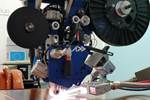Heraeus, University of Sheffield AMRC partner to develop innovative composite technologies
Tier 2 membership enables Heraeus Noblelight to explore filament winding capabilities using its humm3 technology for rapid layup of thermosets, dry fiber and thermoplastics.

humm3 at MF TECH. Photo Credit: MF TECH
Flash systems technology company Heraeus Noblelight Ltd. (Cambridge, U.K.) has become a Tier 2 member at the University of Sheffield Advanced Manufacturing Research Centre (AMRC, Rotherham, U.K.). This membership gives Heraeus Noblelight access to the AMRC’s world-class research and development facilities to increase the technology readiness level of filament winding for composite pressure vessels and pipes using its humm3 heating technology for automated fiber placement (AFP).
“We are delighted to take the opportunity to confirm our commitment to the AMRC by joining as a member,” says Peter Lascelles, senior sales manager for humm3. “This enables us to explore the capabilities of using thermoplastics for filament winding using our humm3 heating technology. It is a fantastic opportunity, as we can develop the use of filament winding and how this may bring about innovations in the hydrogen and green economy.”
As part of its membership, Heraeus Noblelight says it will be leading a project with the AMRC to investigate the use of its humm3 technology for high-speed filament winding of thermoplastic components for composite pipes and pressure vessels.
“Our partnership has potential and, through close collaboration, we can use Heraeus’ expertise to enhance our own capabilities in rapid composite manufacture,” says Dr. Betime Nuhiji, technical lead at the AMRC Composite Centre. “The humm3 heating system is an emerging technology that is proving to be more sustainable, safe and affordable compared to the current laser heating methods used in aerospace and automotive sectors. Collaboratively, there is an opportunity to integrate this technology with the AMRC’s filament winding and AFP systems and eliminate the need for a post-consolidation step. This could potentially reduce energy consumption and increase production rates for the manufacture of composite components.”
Related Content
-
Plant tour: BeSpline/Addcomp, Sherbrooke, QC, Canada
Composites automation specialist increases access to next-gen technologies, including novel AFP systems and unique 3D parts using adaptive molds.
-
McClarin Composites partners with ExxonMobil to accelerate high-speed RTM
Multimillion-dollar investment to drive next-gen automated RTM technology will open new applications and markets for composites OEMs.
-
Mold 3D printing helps automate composite bathtub, shower production
As part of its efforts to automate as much of its production process as it can, Lyons Industries acquired a Massivit 10000 additive manufacturing system to quickly produce high-performance molds and support fixtures.












